Tregaron lies on the River Brenig, a tributary of the River Teifi, about nine miles north-east of Lampeter. It is an ancient market town, which served all of the rural communities locally, and was a well known stop off on the droving route. The men of Tregaron who fell during both World Wars are commemorated on two plaques which are displayed on the wall of the Memorial Hall, which was opened on 4 January 1922. The presence of a tuberculosis hospital (sanatorium) here during the war meant that several men died here who are not commemorated locally even though they are buried at Tregaron. These men are included below.
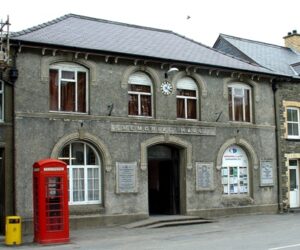
The Great War, 1914-1918
William Ansell, Private, 18162, South Wales Borderers. William was born at King’s Cross, London in 1895, and by 1911 was residing at Tregaron, where he worked as a Farm Labourer at Pant y Craff. He enlisted at Aberystwyth into the 5th Battalion, South Wales Borderers, which was attached to 58 Brigade, 19th (Western) Division. The Division moved to France during July 1915, and moved to positions near Loos, where it took part in the opening attack of the Battle of Loos on 25 September 1915. The following year the Division moved to the Somme, where it took part in the second wave of the attack on Ovillers-La Boiselle on 1 July, capturing the village at heavy cost. It then fought through the Somme Battles of Pozieres and the Ancre in 1916. In 1917 the Division moved North to Ypres, taking part in the Battle of Messines, and the main Third Battle of Ypres. In 1918 they were caught up in the German Spring Offensive near St. Quentin, where they suffered terrible casualties, and fought at the Battle of Bapaume. They moved to Ypres, but were caught up in the German attack at Messines. William was killed in action here on 11 April 1918, aged 22. He has no known grave, and is commemorated on the Tyne Cot Memorial, Belgium.

Richard Archibald Beaton, Private, 37016, Royal Army Service Corps. Richard was the son of Alexander and Mary Beaton, of Elswick, Northumberland. Prior to the war he resided with his wife, Bessie, at Newcastle, where he worked as a Theatre Manager. Richard died at Tregaron on 29 June 1921, aged 48, and is buried at Tregaron (St. Caron) Churchyard Extension. Richard is not commemorated on the Tregaron War Memorial.
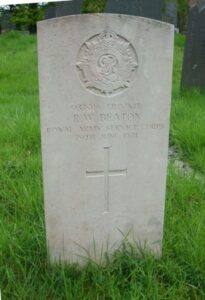
David Davies, Signalman, Wales Z/3105, Royal Naval Volunteer Reserve. David was born on 26 September 1888, the son of John and Mary Davies, of Glanrafon Farm, Tregaron. He served with the Royal Navy aboard HMS Pheasant, an M Class Destroyer. David was killed when pheasant struck a mine and sank off Orkney on 1 March 1917. He was 28 years old, and is commemorated on the Plymouth Naval Memorial, Devon.
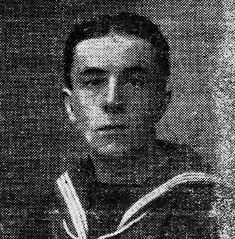
John Davies, Cadet, 175380, Royal Air Force. John was the son of Daniel and Elizabeth Davies, of Pencastell y Farw, Llangeitho. He enlisted into the Royal Air Force in 1918, training as Cadet. John died at RAF Uxbridge on 8 December 1918, after being injured in a motor car crash at London. He was 19 years old, and is buried at St. Caron Churchyard Extension, Tregaron.
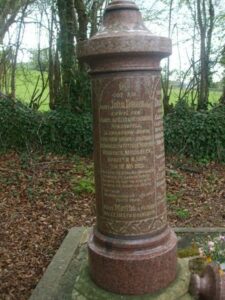
Charles Edmunds, Driver, 730809, Royal Field Artillery. Charles was born in 1894, the son of John and Anne Edmunds, of Tyhen, Tregaron. He served during the war with A Battery, 266th Brigade, Royal Field Artillery, in the Egyptian and Palestinian campaigns. Charles survived the war, but became ill, and died on 13 January 1919, aged 26. He is buried at Alexandria (Hadra) War Memorial Cemetery, Egypt.
John Edwards, Private, 18702, Welsh Regiment. John was the son of Mrs. E. Edwards, of 7, High Street, Doldref, Tregaron. He had served throughout the war with one of the service battalions of the Welsh Regiment, which was attached to 114 Brigade, 38th (Welsh) Division, and had landed in France with the Division on 2 December 1915. John had been sent home at some time, and attached to the 3rd Battalion, Welsh Regiment. He was discharged from the army on 6 March 1918, and died at Chelsea Military Hospital on 29 November 1918, aged 32. John is buried at Tregaron (Bwlchgwynt) Calvinistic Methodist Chapelyard. John is not commemorated on the Tregaron War Memorial.
Thomas Richard Edwards, Private, 4407, Honourable Artillery Company. Thomas was born in 1882, the son of John and Anne Edwards, of Nantstalwen, Tregaron. He enlisted at Armoury House, London in October 1915 into the Honourable Artillery Company. He embarked for France on 13 March 1916, joining the 1st Battalion, Honourable Artillery Company, which was attached to 190 Brigade, 63rd (Royal Naval) Division. Thomas fought with the battalion on the Somme, during the Battle of the Ancre in 1916. In April 1917 the Division were at Arras, and fought at the Second Battle of the Scarpe, where they captured Gavrelle. Thomas began suffering back pains at Arras, and was evacuated to 42 Casualty Clearing Station. He arrived back in England on 28 June 1917, diagnosed as suffering from lumbago and myalgia, and died in hospital on 14 July 1917. Thomas was 34 years old, and is buried at Tregaron (Bwlchgwynt) Calvinistic Methodist Chapelyard.
Evan Evans, Private, 69143, Royal Welsh Fusiliers. Evan was the son of Evan and Anne Evans, of Tynwaun, Tregaron. He enlisted at Brecon into the army, and was posted to France in 1917, joining the 13th Battalion, Royal Welsh Fusiliers, which was attached to 113 Brigade, 38th (Welsh) Division. Evan probably joined the battalion at Boesinghe. Here they fought at the Battle of Pilckem Ridge, and the Battle of Langemarck. They then moved to Armentieres, where they remained from September 1917 until March, 1918 when the German Spring Offensive was launched. The British had been over-run on the Somme, and so in April the Division was moved South, taking up positions North of Albert. Evan was killed in action here on 7 April 1918. He was 23 years old, and is buried at Bouzincourt Ridge Cemetery, Albert, France.
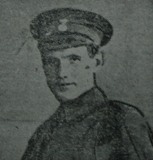
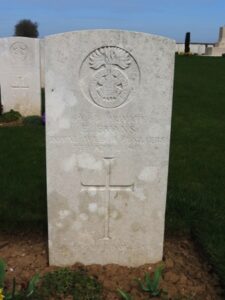
David Green, Lance Corporal, 28381, Cameronians. David was born in Islington, London in 1897, the son of George Green and Hannah Jane Green (nee Jones). His father was a native of Tregaron, but had moved the family to 124, Harlesden Road, Willesden Green, London just prior to David’s birth and he was the first of the families eight children to be born in the capital. David enlisted at Harlesden into the Highland Light Infantry, and was posted to Salonika in 1916, where he was transferred to the 11th Battalion, Cameronians, which was attached to 77 Brigade, 26th Division. David was killed in action during the Second Battle of Doiran, on 19 September 1918, aged 21. He has no known grave, and is commemorated on the Doiran Memorial, Salonika. David does not appear to be commemorated locally.
Evan Griffiths, Private, 59180, Northumberland Fusiliers. Evan was born at Llanbadarn in 1895, and was the Nephew of Morgan Jones, of Bryngaron, Tregaron. He enlisted at Lampeter into the Army Service Corps, but was posted to France with the 19th Battalion, Northumberland Fusiliers, which was attached to the 35th Division as the Pioneer Battalion. The Division moved to France on 29 January 1916, and saw its first major action during the Battle of the Somme. The Division followed the German Retreat to the Hindenburg Line in March 1917. Later in the year they moved north to Ypres, and fought at the Second Battle of Passchendaele. By Spring of 1918 they were back on the Somme, and fought at the First Battle of Bapaume, during the German Offensive. Evan was killed on the Somme on 28 March 1918, during the desperate fighting which ensued. He was 22 years old, and is commemorated on the Pozières Memorial, France.

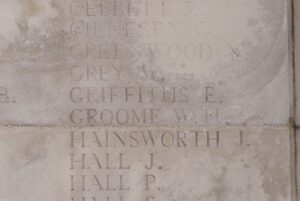
Thomas Arthur Hughes, Private, G/9382, Queen’s Own Royal West Kent Regiment. Thomas was born at Bangor in 1895, the son of Hugh and Elizabeth Hughes, of 5, Garth Terrace. He served with the Queen’s Own Royal West Kent Regiment during the war, and was in France during 1916. Thomas was invalided home at some stage after being gassed, and died at Tregaron Hospital on 24 September 1917. He was 22 years old, and is buried at Tregaron (St. Caron) Churchyard Extension. Thomas is not commemorated on the Tregaron War Memorial.
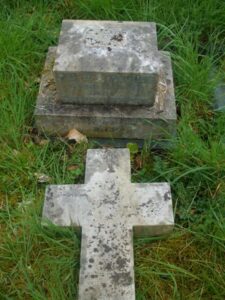
George Percy Innes-Kerr, Seaman, Royal Naval Reserve. George was born in Aberdeen on 20 April 1890. He married Angela C. Nierynck, the daughter of Belgian refugees, at Haverfordwest in 1917. He served with the Royal Navy, at HMS Vivid, the shore establishment at Portsmouth. George died at Tregaron Hospital on 27 July 1918. He was 29 years old, and is buried at Tregaron (St. Caron) Churchyard Extension. George is not commemorated on the Tregaron War Memorial.
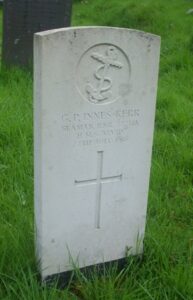
John David Jones, Private, 117652, Machine Gun Corps. John was the son of David and Rachel Jones, of 4, Brenig Terrace, Tregaron. He worked as a Tailor for his father at Tregaron prior to the war. John at Lampeter into the South Wales Borderers and married Catherine Mary Williams, a schoolteacher at Tregaron School, whilst on leave in 1916. John was then transferred to the 255th Machine Gun Company at Grantham. The Company embarked for France at Southampton on 13 November 1917 and landed at Le Havre two days later, before entraining for Mont St. Eloi, near Arras, joining the 47th (2nd London) Division. On 22 November the Company marched to Dainville and over the coming days marched to Beaulencourt, before moving from there to Beaumetz-Les-Cambrai. By now the Battle of Cambrai had begun and heavy fighting was raging along the Cambrai front, so the 255th MG Company took up positions along the Bapaume to Cambrai Road on 28 November, relieving the 201st MG Company in a ruined factory. The Company suffered heavy German artillery fire over the coming days, which knocked out several gun-crews, but held its positions, providing machine-gun fire onto positions around Bourlon Wood. John was killed in action here on 2 December 1917, whilst his Company was providing fire on Bourlon Wood. The 32-year-old has no known grave and is commemorated on the Cambrai Memorial, Louverval, France. John is also commemorated on the Tregaron war memorial.
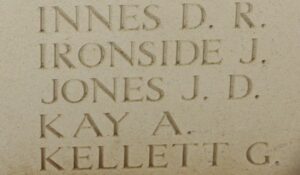
John Rowland Jones, Private, 27998, Royal Welsh Fusiliers. John was born in 1884, the son of Rees and Mary Jones, of the Emporium Shop, Tregaron. He worked as a Drapers Assistant at Tregaron before moving to London after gaining a position as a Clerk. John enlisted at Holborn into the 18th Battalion, Royal Welsh Fusiliers on 14 August 1915. He joined the battalion at Kinmel Park, where it was a reserve unit for the 38th (Welsh) Division. On 12 February 1916 John was transferred to the 22nd Battalion, Royal Welsh Fusiliers, which was another reserve unit at Kinmel Park, then was drafted to France on 14 July 1916, joining the 2nd Battalion, Royal Welsh Fusiliers, which was attached to 19 Brigade, 33rd Division. By 16 July the 2nd RWF were bivouacked in the newly captured Mametz Wood, and moved to Bazentin-le-Petit two days later, to take part in the assault on High Wood. The battalion suffered heavy casualties at High Wood, and moved back into reserve at Buire-sur-L’Ancre until 6 August and then spent several days at Becordel before moving back into the line at High Wood on 18 August, and helped beat off a German counter-attack. On 22 August 1916 the 2nd RWF moved into the support line at Bazentin-le-Grand, and six men were killed by artillery fire during their relief. During the coming weeks the 2nd RWF received several drafts of reinforcements, and on 8 December the now fully rebuilt battalion moved to new positions at Suzanne, between Bapaume and Péronne. The Division remained in this sector over the coming months, before being transferred to the Arras sector, and reached Henin by 13 April, before the Division took over a section of front line facing the Hindenburg Line. The infantry battalions of the division then began the usual routines of rotating between the front-line, support and reserve trenches and the 2nd RWF took over a position known as Tunnel Trench. On 23 April the 2nd RWF took part in a costly assault on the Hindenburg Line, suffering heavy casualties. The battered battalion then moved to a rest camp at Basseux to rebuild, and by 15 May moved back into the line in the Croisilles Sector. The Division then carried out several assaults against the Hindenburg Line, but could not breach it, so on 27 May 1917 a large-scale assault was carried out again, with the 2nd RWF in the thick of the action. John was killed in action during the assault that day. The 32-year-old has no known grave and is commemorated on the Arras Memorial, France. John is also commemorated on the Tregaron war memorial.
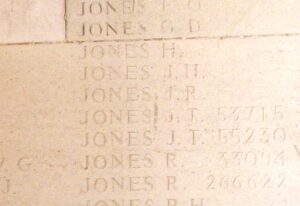
Morgan Jones, Private, 63504, South Wales Borderers. Morgan was the son of John Jones and Martha Jones, of Monarch House, Tregaron. He enlisted at Brecon into the 3rd Battalion, South Wales Borderers in 1917. The battalion was the Reserve Battalion for the 1st and 2nd Battalions, and was based at Hightown, near Liverpool, where it formed part of the Mersey Garrison. Morgan became ill whilst in training at Liverpool and was invalided to Windy Knowe VAD Hospital in Blundellsands, Liverpool for treatment. He died there of pneumonia on 5 June 1918. The remains of the 19-year-old were conveyed home and he was buried in St. Caron’s Churchyard Extension, Tregaron.
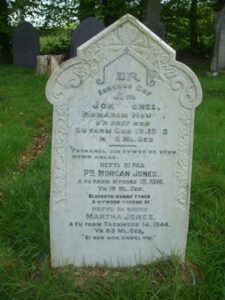
Rees Jones, Sapper, 151552, Royal Engineers. Rees was born at Tregaron, the son of Daniel and Mary Jones. He lived at 6, Office Street, Cymmer, Porth prior to the war, and enlisted there into the Somerset Light Infantry. Rees landed in France on 25 July 1915, and joined the 255th Tunnelling Company, Royal Engineers. The tunnelling company’s were used for very secretive underground warfare, where they dug tunnels underneath German positions and laid massive mines of ammonal explosive to create gaps in the German front during an assault. Rees was wounded at Ypres, and died in a casualty clearing station on 30 November 1917, aged 31. He is buried in Dozinghem Military Cemetery, Belgium. Rees does not appear to be commemorated locally.
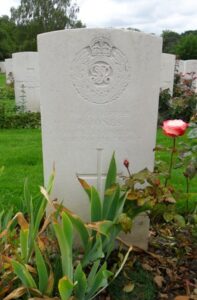
William Jones, Private, 37343, Welsh Regiment. William was the son of John and Jane Jones, of the Crown and Anchor, Tregaron. He enlisted at Aberystwyth into the 9th Battalion, Welsh Regiment, which was attached to 58 Brigade, 19th (Western) Division. The Division moved to France during July 1915, and moved to positions near Loos, where it took part in the opening attack of the Battle of Loos on 25 September 1915. The following year the Division moved to the Somme, where it took part in the second wave of the attack on Ovillers-La Boiselle on 1 July, capturing the village at heavy cost. It then fought through the Somme Battles of Pozières and the Ancre in 1916. In 1917 the Division moved north to Ypres, taking part in the Battle of Messines, and fought throughout the Third Battle of Ypres. In 1918 they were caught up in the German Spring Offensive near St. Quentin, where they suffered terrible casualties. They moved to Ypres, but were caught up in the German attack at Messines. After suffering terribly again, they moved south to the quieter French sector to rebuild, but were caught up in the German offensive on the Aisne. William had fought with the battalion throughout all of its time at war, but was killed in action on the Aisne on 5 June 1918. He was 27 years old, and is buried at Chambrecy British Cemetery, France.
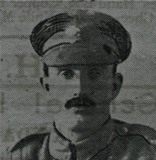
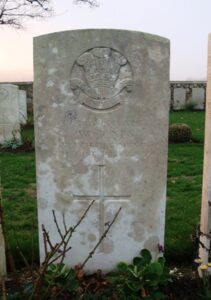
William Rice Jones, Lance Corporal, 6509, Honourable Artillery Company. William was born in 1889, the son of William and Annie Jones, of Ochor, Tregaron. William worked as a Shop Assistant at London prior to the war, and enlisted at Armoury House in November 1915, into the 3rd Battalion, Honourable Artillery Company. William was posted to France in November 1916, joining the 1st Battalion, Honourable Artillery Company, which was attached to 190 Brigade, 63rd (Royal Naval) Division. He fought with the Division during the Battle of the Ancre, and in 1917 fought throughout the Battle of Arras. On 24 November 1917, William volunteered to serve with the Royal Flying Corps. He became an air cadet at RAF Wyton, where he began to train for his pilot’s licence. At 09.30 on the morning of 13 September 1918, William took off from Harling Road in an R.E.8., Serial C2484, detailed with delivering the aircraft to RAF Wyton. William had flown over 47 hours solo by now, and was regarded as being of above average talent. Mysteriously his aircraft spun into a dive, and crashed at Wyton on 24 November 1918, killing William instantly. He was 29 years old, and is buried at Tregaron (Bwlchgwynt) Calvinistic Methodist Chapelyard.
Evan Lewis, Private, 50487, Imperial Camel Corps. Evan was the son of Thomas and Martha Lewis, of Penrheol Cottage, Tregaron. He enlisted in November 1914 into the Pembroke Yeomanry. During March 1916 the 1/1st Pembroke Yeomanry moved to Egypt, where it merged with the Welsh Border Mounted Brigade and formed the 4th Dismounted Brigade. Evan was posted to the 5th Company, Imperial Camel Corps, which was attached to the Egyptian Expeditionary Force. Evan fought in the campaign against the Senussi Tribesmen in Egypt, and from March 1917 took part in the Sinai Campaign, the advance into Palestine, and the Arab revolt. Evan survived the war, but died in hospital at Turin on 10 April 1919. He was 25 years old, and is buried at Turin Town Cemetery, Italy.
Peter McElroy, Private, 39794, Welsh Regiment. Peter was a Farm Labourer in Marros, Pendine prior to the outbreak of the Great War. He enlisted on 11 November 1915 at Carmarthen, and served as a Private, number 39794, with the Welsh Regiment. Peter was relatively old for the rigours of military service though, and was discharged on 8 March 1917 as no longer fit for war service, due to suffering from tuberculosis. His address at demob was given as 32, Bridge Street, Carmarthen and one of the Medical Boards was at Pembroke Dock. Peter died of Tuberculosis aged 46, on 12 May 1918. He is buried at Tregaron (St. Caron) Churchyard Extension, Ceredigion. Peter is not commemorated on the Tregaron War Memorial, but at Marros, near Pendine.
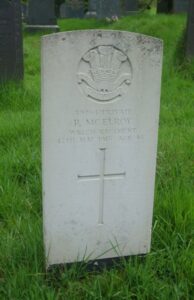
Alun Morgan, Private, 60219, Welsh Regiment. Alun was born in 1898, the son of Jane Morgan, of Pwllswyddog, Tregaron. He enlisted at Abertillery into the Welsh Regiment, and in 1918 was posted to France, joining the 24th Battalion, Welsh Regiment (Pembroke & Glamorgan Yeomanry), which was attached to 231 Brigade, 74th (Yeomanry) Division. Due to the terrible casualties suffered by the British on the Western Front in March and April 1918 the Division was recalled to the Western Front, and arrived at Marseilles during May 1918. They then fought at the Second Battle of Bapaume during the great offensive, and fought in Flanders before returning to the Somme and fighting at the Battle of Épehy, as part of the offensive towards the Hindenburg Line. Alun was wounded just after the battalion moved back to Flanders, and died in hospital on 4 October 1918. He was 20 years old, and is buried at Bethune Town Cemetery, France.
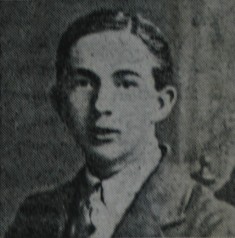
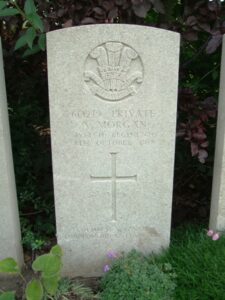
Herbert James Morgan, Private, 26566, King’s Shropshire Light Infantry. Herbert was born in 1896 at Condover, Shropshire. He had been brought up in 2, Garden View, Tregaron, with his Aunt Kate and her husband, Edward Griffiths, but had resided at Paytoe Hall, Leintwardine Herefordshire prior to the war. He enlisted on 28 October 1914 into the Shropshire Yeomanry. Herbert was sent to France on 20 September 1916, joining the 6th Battalion, King’s Shropshire Light Infantry, which was attached to 60 Brigade, 20th (Light) Division. The Division was on the Somme, and Herbert joined the battalion in time to take part in heavy fighting near Maltz Horn Farm. He was seriously wounded early in October, suffering gunshot wounds to his thighs, feet, left arm and left ear, and was invalided home to the Dundee V.A.D. Hospital. After undergoing several months in hospital, Herbert was discharged, and went to live with his aunt at Pendine House, Tregaron. He died there on 4 May 1918, aged 21, and is buried at Tregaron (St. Caron) Churchyard Extension. Herbert is not commemorated on the Tregaron War Memorial.
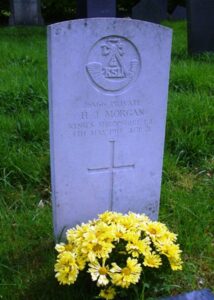
Arthur John Quinn, Private, 33102, Loyal North Lancashire Regiment. Arthur was the son of John and Alice Mary Quinn, of 13, Bell Green, Lower Sydenham, London. On 2 May 1911 he married Jane Lodwick, of Tegfan, Tregaron, and the couple had a son, John, who was born in 1912. Arthur enlisted at Camberwell into the Rifle Brigade, and was posted to France in 1916, joining the 10th Battalion, Loyal North Lancashire Regiment, which was on the Somme attached to 112 Brigade, 37th Division. It saw heavy fighting during the attack on the Gommecourt Salient on 1 July 1916, and fought throughout the offensive that summer. Arthur was killed in action during the Battle of the Ancre, on 23 November 1916, aged 28. He has no known grave, and is commemorated on the Thiepval Memorial, France. Arthur does not appear to be commemorated locally, although Jane returned to Tregaron after the war.
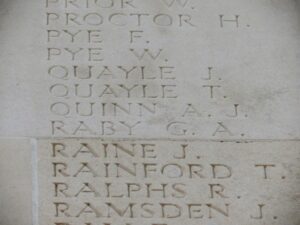
Thomas John Rees, Private, 31278, Machine Gun Corps. Thomas was the son of Thomas and Margaret Rees, of Meadow Villa, Tregaron. He was a student at Lampeter prior to enlisting there on 9 December 1915 into the South Wales Borderers, but was transferred to the Machine Gun Corps on 11 April 1916. Thomas didn’t serve overseas, but became ill with tuberculosis, and died at Bilton Park Military Hospital on 8 May 1917. He was 22 years old, and is buried at Tregaron (Bwlchgwynt) Calvinistic Methodist Chapelyard.
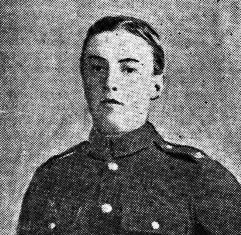
Thomas Richards, Private, 13852, South Wales Borderers. Thomas was the son of David and Selina Richards, of Tregaron. By 1903 he had married, and lived with his wife Elizabeth Annie Richards, at 19, Thomas Street, Trethomas, Bedwas. Thomas enlisted at Newport into the 7th Battalion, South Wales Borderers, which was attached to 67 Brigade, 22nd Division. The division moved to France during September 1915, but was almost immediately transferred to Salonika, to counter the Bulgarian move into Greece. Thomas was killed in action in Salonika on 21 January 1917, aged 32, and is buried in Karasouli Military Cemetery, Salonika. He does not appear to be commemorated locally.
William Rowlands, Private, 307279, Lancashire Fusiliers. William was born at the Railway Hotel, Tregaron in 1885, the son of Thomas and Mary Rowlands. By 1911 he had moved to 45 Thornwood Place, Treharris where he worked as a colliery haulier and later lived with his wife Lilian and their two children at 6, Kiln Street, Aberdare. He enlisted at Cardiff into the army and was posted to France joining the 1st/7th Battalion, Lancashire Fusiliers, which was attached to 125 Brigade, 42nd (East Lancashire) Division. The division moved to France on 27 February 1917 following service at Gallipoli and in Egypt. It took over the line near Épehy before moving north to take part in the Passchendaele offensive, refitted in September before moving to the Givenchy sector. It took part in the actions following the launching of the German spring offensive from 21 March 1918, then later that year took part in the launching of the 100 days offensive, from 21 August. William was killed in action on the second day of the great offensive, on 22 August 1918, aged 32. He has no known grave and is commemorated on the Vis-en-Artois Memorial, Haucourt, France. He does not appear to be commemorated locally.
James Haydn Thomas, Private, 59302, Northumberland Fusiliers. James was the son of David and Susannah Thomas, of Cambrian House, Tregaron. He enlisted at Lampeter into the Army Ordnance Corps, but was transferred to the 25th (2nd Tyneside Irish) Battalion, Northumberland Fusiliers, which was attached to 102 Brigade, 34th Division. The Division moved to France during January 1916, and saw its first major action on the Somme, during the Battle of Albert, where it suffered very severe casualties during its part in the attack on La Boisselle. It then took part in the Battle of Bazentin, Battle of Pozieres and the Battle of Flers-Courcelette. The following year saw them fighting at Arras, during the First and Second Battles of the Scarpe, and the Battle of Arleux. In March 1918 the Division were in the St. Quentin sector, and were hit by the German Spring Offensive on 21 March 1918. James was killed in action here on 21 March 1918. He was 21 years old, and is commemorated on the Arras Memorial, France.
World War Two, 1939-1945
Evan Rhystyd Davies, Trooper, 6351921, Royal Armoured Corps. Evan was the Husband of S. Davies, of Tregaron. He served with the 162nd (9th Bn. Queen’s Own Royal West Kent) Regiment, Royal Armoured Corps, which was attached to the 79th Armoured Division. Evan died in an accident in a tank whilst on active service on 11 March 1943. He is buried at Tregaron (Bwlchgwynt) Calvinistic Methodist Chapelyard.
John Davies, Driver, 117331, Royal Army Service Corps. John was the son of John Powell Davies and Elizabeth Anne Davies, of Tregaron. He served with the Royal Army Service Corps. John had probably served in the North African campaign, before taking part in the invasion of Italy. He was killed in Italy on 12 November 1944, aged 26, and is buried at Meldola War Cemetery, Italy. John does not seem to be commemorated at Tregaron.
David Daniel Jones, Midshipman, Royal Navy. David was born at Tregaron, the son of Moses and Mary Elizabeth Jones. The family later resided at Kilburn, Middlesex, and David enlisted into the Royal Navy. He served at HMS Macaw, the Royal Naval Air Station at Errol Airfield near Bootle in Cumbria. David died on active service on 22 July 1944. He was 19 years old, and is buried at Tregaron (Bwlchgwynt) Calvinistic Methodist Chapelyard. His brother, Evan also fell.
Evan Benjamin Jones, Sub-Lieutenant (A), Royal Naval Volunteer Reserve. Evan was born at Tregaron, the son of Moses and Mary Elizabeth Jones. The family later resided at Kilburn, Middlesex, and Evan enlisted into the Royal Navy. He served at HMS Landrail, the Royal Naval Air Station near Campbeltown in Argyll and Bute, Scotland. On 8 September 1942, Evan was one of three men aboard the Fairey Albacore L7109, which took off from RNAS Campbeltown on a night flying exercise. The aircraft was flying low, and the undercarriage caught a wire fence, which sent it crashing into the ground. All three men were killed in the accident. Evan was 29 years old, and is buried at Tregaron (Bwlchgwynt) Calvinistic Methodist Chapelyard. His brother, David, also fell.
Tom Huws Rees, Flying Officer, 152425, Royal Air Force Volunteer Reserve. Tom was the son of John and Mary. E. Rees, of Tregaron. He served as a Wireless Operator/ Navigator with 418 (R.C.A.F.) Squadron, Royal Air Force. The squadron was an elite unit, equipped with the De Havilland Mosquito. On 14 May 1944 Tom was in his Mosquito, piloted by Willard Harper, on a day-ranger mission over France. The Mosquito was last seen shooting up some aircraft hangars on Luxeuil airfield, and was probably brought down by flak, killing both men. Tom was 21 years old, and is buried alongside his pilot at St. Germain Communal Cemetery, France. Tom does not seem to be commemorated at Tregaron.